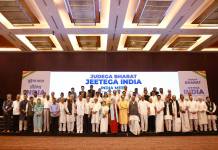For its importance in national politics and economy, Uttar Pradesh has a miserable record and lags behind in almost all development indices, earning it a permanent position among the BIMARU states.
The political situation in the state is much to be blamed for. For nearly two decades until 2007, no government in the state lasted full term. Short-lived governments did not bring policy stability and the state continued to suffer. The industry is much less developed than in other parts of India. Despite being endowed by natural wealth, the state is abysmally poor. Education and health sectors are in shambles, criminality is plentiful and lawlessness rife.
The Hindi heartland of the nation is plagued by a plethora of social issues which get lost in the gridlock of politics.
Rule of gun
The first and foremost issue which comes to notice is lawlessness and increase in crime. Safety of women remains another major concern. Uttar Pradesh is infested with hooligans and troublemakers. The National Crime Records Bureau data for 2014 puts UP at the top of the list with the highest crime rate at 12.7 % of the total crimes committed in India, making the state more notorious than even Delhi (5.7%), Bihar (10.4%) and Maharashtra (9.8%).
A report published in The Economic Times brought some horrifying numbers to the table. Under Chief Minister Akhilesh Yadav, the number of violent crimes touched a high of 33,824 incidents in 2012, including nearly 2,000 rapes and 4,966 murders.
The situation wasn’t any better when the BSP leader Mayawati headed the government. The number of violent crimes reported was 32,987 including a similar count of rapes and murders. Crime against women has intensified in the past decade. In 2013, 9,737 women were kidnapped while in 2012, this figure was 7,910.
Absence of law during the BSP and SP rule is visible in the growing numbers. Under Akhilesh’s term, atrocities on Dalits increased manifold. In most areas, law and order situation has worsened as extreme Yadavisation of the police force has pushed the Dalits into uncomfortable zones.
The situation has amplified under the two consecutive bureaucratic regimes. India’s largest state with its burgeoning population may be difficult to police but if the criminals are protected by the law, there is not much hope left for those who want to lead a life of security and dignity.
Under the BSP and SP rule, high level police postings based on caste have given the culprits a free run. With each government passing the blame for the situation to its predecessor, criminals roam freely in the state. The ruling party (SP) itself tops the list of candidates with criminal records. According to an estimate, around 795 candidates out of a total of 2195 who have contested elections so far, have criminal records.
Communal fire
The state, since long, has been the epicentre of communal hatred and Hindu-Muslim rivalry. Akhilesh Yadav’s tenure has been sprinkled with a fair dose of communal riots. The 2013 Muzaffarnagar riots have been described as the worst violence in Uttar Pradesh in recent history as the riots claimed more than 70 deaths and left more than 50,000 displaced from their native places. To control the situation, Army was deployed in the state for the first time in the last 20 years. The Supreme Court held the incumbent chief minister and his government guilty of negligence in preventing the violence.
With each party chasing its vote bank, communal politics in Uttar Pradesh has widened the gap between Hindus and Muslims. As if Pakistan fuelled terrorism was not enough, the ballot-box terrorism is destroying the delicate balance of inter-religion friendship and harmony. Hate speeches, communal propaganda are being increasingly used for garnering support on communal lines.
Healthcare in shards
According to the Uttar Pradesh Directorate of Family Welfare, growing population and rapid urbanisation coupled with poverty are leading to failure of the state healthcare. UP has the highest incidence of child malnutrition in the country.
Maternal mortality rates, that is, mothers dying while giving birth due to lack of adequate facilities, is at 292, against the national average of 178.
With 80 out of every 1,000 newborns dying, infant mortality rate is second from the bottom on the human development index of Indian states. Lower access to institutional births and lower coverage of immunisation are the biggest hurdles to maternal and neonatal health.
The state also has high prevalence of infectious diseases on account of poor living environment in rural as well as urban areas with high density of population. Majority of population has low access to housing, safe drinking water and sanitation.
The provision of piped water supply still remains an underachieved goal in Uttar Pradesh. A large part of the state households depend on their own private tube-wells and pumps for their daily water needs. Statistics show a low coverage for both household sanitation and drainage service compared to all India level.
As per the Census 2011, about 35% households have individual toilets. 64% of UP defecates in the open due to lack of toilets.
A number of barriers exist which impede the growth of healthcare in the over populous state. Irregular employment, struggle for livelihood, low literacy levels, large proportion of poor living in slums and migrant workers have stretched the already weak healthcare services.
Uneven distribution of primary healthcare centres in urban areas and lack in rural, have weakened the well-being of the state. Narrow social thinking and lack of family support has resulted in neglect of women’s health. There is also wide prevalence of cultural practices which have been found to be harmful for the health of the mother/caregiver.
Poverty & Employment generation
For a state which has provided the country with eight prime ministers, UP is an under-achiever in terms of social development. The state remains one of the poorest and most backward states in India. With 32% of its population living below the poverty line, the state ranks fourth from the bottom in per capita index. While poverty eradication and employment generation are the most promised goals in every election manifesto, the socio-economic condition of the poor remains lower than national average. Majority of UP’s poor live in rural areas. Decline in agriculture and shift of rural youth towards service sectors have added to the issue.
Although a large number of programmes have been introduced by the various governments, proper implementation and fair usage of state funds for social welfare projects is marred by rampant corruption and administrative neglect. Preferential caste based enrolment in reserved government jobs has further pushed the weaker minorities down the development index. According to Census 2011 data, the Dalit family proportion in government jobs has fallen. What Mandal Commission sought to achieve, is lost in the favours and patronage of the ruling majority. While Mayawati filled reserved positions with Dalits, Akhilesh Yadav has outdone her giving the maximum possible seats to his Yadav brethren.
Employment opportunities are continuously declining in public as well as private sectors in the state. The National Sample Survey Organisation (NSSO) puts the projection of unemployed youth in Uttar Pradesh in the age group of 15-35 at whopping 1 crore by the end 2017. There is also an alarming decline in the number of agriculture workers. Only 52.4% of the total workers are engaged in the agricultural sector as against 78% five years back. This affects the already poor performance of the agriculture sector which is growing a slow rate of 3-4%, much below the state’s potential. Irregularity of work in the farms and non-payment of minimum wages is one of the reasons for shift of workers from agriculture to other sectors.
Poor education infrastructure
Throughout the state, the infrastructure of government primary schools is pathetic and shows the negligence of the administration in providing quality education, which not only leads to eradication of poverty but is also the basic right of every individual. In the maximum number of primary schools, the teacher-student ratio is nearly 50:1.
Government schools have poor infrastructure with dilapidated building, lack of teaching staff, furniture, clean drinking water shortage and insufficient playgrounds. Lack of toilets is one of the prime reasons for the dropout of children, especially the girl child from the school system. The primary education sector needs standardization and better monitoring system. Majority of government schools in the state do not adhere to the RTE compliance. The drop-out rate in primary schools is high at 10.3%.
As the elections draw close, just like his predecessors, Akhilesh Yadav too is trying to salvage the situation. To show that he has fulfilled his promise of development, he is on a crazy drive of sanctioning mega projects and clearing schemes. Between the state’s worsening law and order situation and its permanent place in the BIMARU group, UP riles under poor governance and neglect of the ruling parties. The new government in 2017 will have a lot to deal with. How it does, will make an interesting study and maybe, leave an example for other states to follow. The countdown has begun.
(With inputs from Hindustan Times, Shodhganga and Times of India)
















